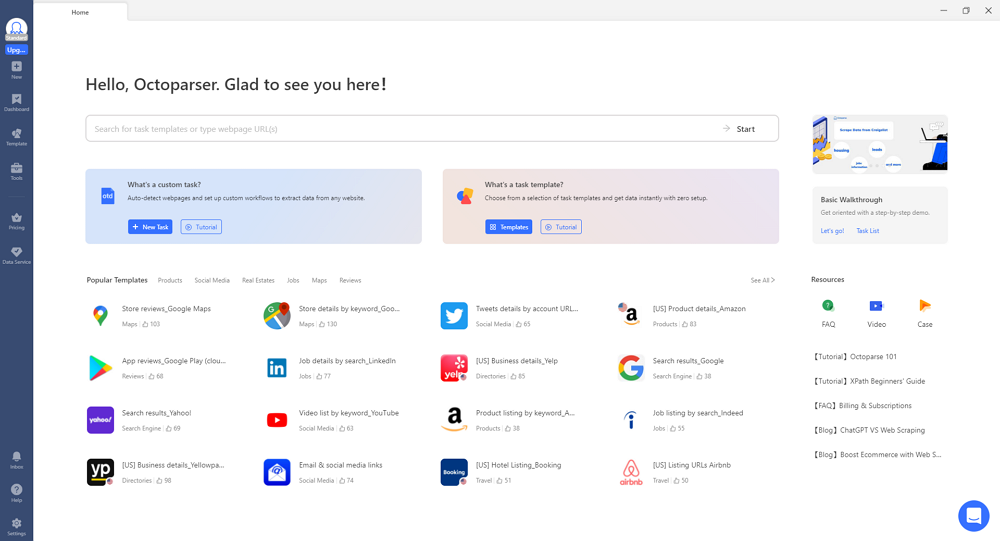Sports analytics is the new frontier in extracting valuable insights that can help improve performance in the modern game. With the right data and proper analysis, teams and players can make better decisions that lead to victories on the field. In this post, we’ll discuss what sports analytics is, how data helps, and how to scrape sports data using Octoparse to take your analysis to the next level.
What is Sports Analytics?
Sports analytics refers to the use of data and statistics to obtain insights that can improve team and player performance. Analytics answer key questions like Which players should get more playing time? Which players are injury risks? What factors correlate with winning? And which tactics are most effective?
What to Achieve From Sports Analytics?
Sports analytics aims to provide several key benefits through data-driven insights
Player evaluation and management
Analytics helps identify which players deserve more playing time based on their performance statistics, efficiency ratings, and impact metrics. Coaches can determine which players need additional coaching and training or maybe trade candidates. By quantifying player value, coaches can optimize their lineups and rotations for maximum results.
Injury risk assessment
Sports organizations can identify which players exhibit behavior or biomechanics that indicate a higher risk of injury based on data from wearables, sensors, and video footage. Analytics reveals how factors like workload, fatigue, training practices, and muscle imbalances correlate with injury likelihood. This knowledge of injury predictors allows preventive measures that can lower risk and keep players healthy.
Outcome prediction
Sports analytics determines which factors best correlate with winning and other performance metrics. Statistical modeling and machine learning accurately predict the outcomes of games and seasons based on metrics like scoring margin, rebounding percentage, three-point shooting, advanced stats, and more. Coaches gain a data-driven edge in strategizing and game planning.
Tactical analysis
Machine learning and neural networks identify which specific strategies, schemes, plays, and tactics produce the best results based on performance data. Analytics also reveals which opponent tendencies are exploitable weaknesses that a team can capitalize on. Coaches have actionable insights into which tactics work best for their personnel.
Skill development
Data reveals precisely which skills and abilities individual players need to improve. Analytics identifies the weak points in players’ games, be it shooting percentage from specific locations, turnover rates, inefficient moves, or other weaknesses. Data then indicates which targeted drills, training methods, and practice regimens are most effective at correcting those weaknesses, allowing personalized development of players’ skills.
By quantifying and analyzing every facet of athletic performance, sports analytics empowers coaches, managers, and players with the insights needed to optimize efforts, maximize potential, and elevate team performance through data-driven decisions at all levels.
How Data Can Help
Data is the lifeblood of sports analytics, providing the insights and answers that drive better decisions and results. A wealth of relevant data is essential for accurate and meaningful analysis. Useful types of sports data include:
Player performance statistics
Game logs detailing traditional and advanced metrics provide the raw material for evaluating player performance. Traditional stats like points, rebounds, assists, steals, blocks, field goal percentage and more remain valuable. However, advanced metrics like true shooting percentage, win shares, value over replacement player, and plus-minus ranking reveal a more nuanced picture of player impact and value.
Video data
Game footage captured by multiple cameras reveals tactical patterns, player movements, decision-making, biomechanics, and more. Advanced computer vision and motion tracking can extract hundreds of data points from every moment of recorded gameplay, from shot selection to pass routes to rebounding patterns.
Injury reports
Reports detailing the nature, severity, and history of player injuries and ailments indicate who is injury prone, who recovers quickly, and who struggles with chronic issues. This data reveals injury predictors and risk factors that analytics can address.
Social media
Mining players’ posts on platforms like Twitter and Instagram provides insights into morale, attitudes, distractions, support systems, and lifestyle factors that impact performance. Analytics can determine which social factors correlate most closely with on-court success or failure.
To gather data at the scale needed for proper sports analytics, organizations use automated web scraping solutions. Web scrapers can extract massive amounts of information from sports websites and social media around the clock.
For instance, a baseball team could program a web scraper to automatically collect pitching statistics like ERA, WHIP, strikeout rate, and batting average against every opposing pitcher by extracting data from MLB.com. The scraper would run repeatedly throughout an entire season, building up a comprehensive dataset of pitching metrics for all of the team’s opponents.
Similarly, a basketball program could create a web scraper to extract injury reports daily for the top 100 college players from sources like ESPN.com. After running for multiple years, the scraper would provide a huge database detailing the types, frequencies, and impacts of injuries at that level of play.
With the right amounts and types of data through technologies like web scraping, sports organizations gain the raw material they need to generate valuable insights through analytics.
How to Scrape Sports Data With Octoparse
There are many sports websites nowadays, and most of them can be valuable sources of web scraping. With Octoparse, you can easily pull wanted data from these websites within several clicks, regardless of coding skills.
Before we begin, please download Octoparse and install it on your device first. When you open the software for the first time, you’ll need an account to log in. Create an account for free, then you can unlock the powerful features of Octoparse in seconds.
Now, you can follow the steps below and get the data you want!
Step 1: Find a sports website to scrape
To start scraping sports data with Octoparse, you’ll need to find a sports website with the data you want to scrape. There are many sports websites to choose from, such as ESPN, Yahoo Sports, or NBA.com.

Step 2: Create a new task
Enter or copy and paste its URL into the search bar on Octoparse. Next, click “Start” to create a new task and let the page load in Octoparse’s built-in browser.
Step 3: Select data with auto-detection
Once the website has loaded in Octoparse’s built-in browser, click on “Auto-detect webpage data” in the Tips panel. Octoparse will scan the page and highlight possible data fields that you can extract. For sports data, these fields could include the names of teams, scores, player statistics, and game schedules. You can preview and rename them in the Data Preview panel at the bottom.
Step 4: Build the workflow
Click on “Create workflow” to build a workflow for your scraping task. The workflow will show each step of the scraper, and you can preview the actions of each step to ensure they’re working correctly.
Step 5: Run the scraper and export the data
Once you’ve built the workflow, double-check all the details and click on “Run” to launch the scraper. You can choose to run the task on your local device or Octoparse’s cloud servers, depending on the size of your project. After the scraping process is complete, you can export the data as an Excel, CSV, or JSON file.
Conclusion
Sports analytics and web scraping are powerful techniques for gaining valuable insights that can improve player and team performance. With the right data and proper analysis, you can discover hidden patterns and inefficiencies that push your knowledge to the next level. Tools like Octoparse make scraping sports data fast and simple, helping you apply data and analytics to your sports knowledge. I encourage you to give it a try – you might be surprised at the insights you discover!




